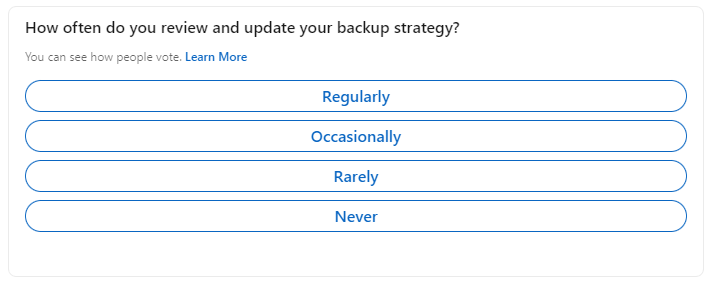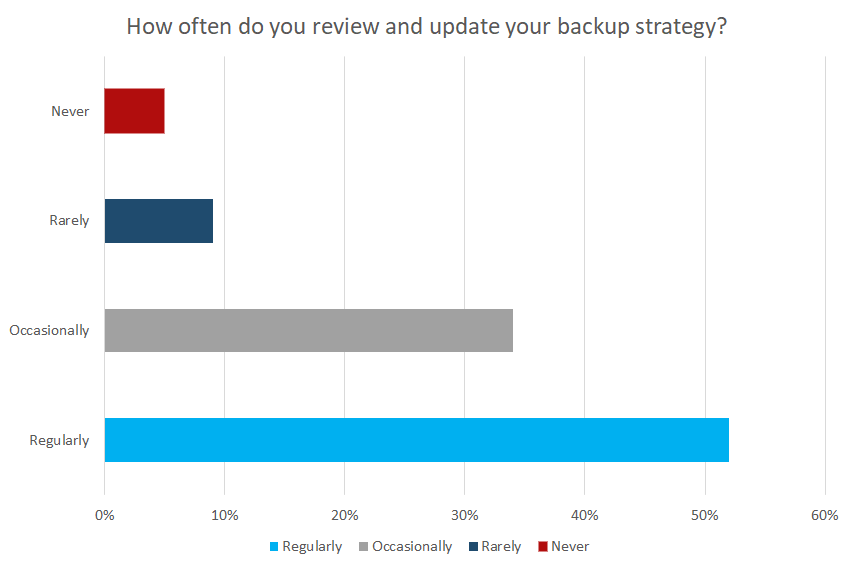Believing that a once-per-year backup strategy review is enough is a dangerous illusion.
The rapid pace of technological change and the growing sophistication of cyber threats and ransomware are relentless barriers that won’t give your business a break.
To gauge current perspectives and practices related to data protection, we recently orchestrated a LinkedIn poll. We honed in on one pivotal aspect: the frequency of reviewing and updating backup strategies.
Businesses Embrace Cloud Backup, But May Overlook Ransomware-Proof DR Strategy
Our poll provided a treasure trove of insights into how businesses manage their data backup strategies. It’s encouraging to see that a substantial percentage of respondents are proactively involved in data backup.
Participants in the poll were asked:

The lion’s share of respondents indicated they review and update their backup strategies either ‘Regularly’ or ‘Occasionally’. This positive trend signifies that businesses are increasingly acknowledging the criticality of robust and up-to-date backup strategies.
The results also unearthed a smaller, albeit noteworthy, group of respondents who indicated that they ‘Rarely’ or ‘Never’ review their backup strategies. This reveals that, despite the positive uptick in businesses investing in backup and disaster recovery strategies, there’s still a gap in data protection practices.

The Necessity of Consistent Backup Reviews and Updates
The importance of frequently reviewing and updating backup strategies cannot be overstated. It’s not just a beneficial habit; it’s crucial for ensuring data integrity and sustaining business operations.
Some of the reasons why this is important include:
- Data Growth: Today’s businesses are experiencing unprecedented data growth. The amount of data handled by organizations is not just increasing, it’s exploding at an exponential rate. A cloud backup strategy that was efficient and robust a year ago may no longer be able to handle the current data volume.
- Technological Progression: The technology landscape is in a constant state of evolution, with new advancements emerging at a breakneck pace. As these advancements unfold, older backup methods may become obsolete, less efficient, or even incompatible with newer systems.
- Risk Reduction: An updated backup strategy plays a pivotal role in mitigating risks associated with data loss. Unexpected events such as hardware malfunctions, human errors, or cyber-attacks can wreak havoc on your data infrastructure.
Yet, despite having backup strategies in place, many businesses still face the grim reality of data loss. A 2022 survey reveals a startling fact: “54% of respondents reported experiencing data loss.”
And while this statistic emphasizes the pressing need for regular cloud backups, it also strongly suggests that implementing a backup strategy is not enough to protect businesses against sophisticated cyberattacks.
Beyond Backups: The Rising Threat of Cybercrime and Ransomware
A sound data backup strategy, while essential, isn’t sufficient to protect against looming threats such as ransomware. As mentioned in TechTarget’s guide to formulating a comprehensive data backup strategy:
Backup is only one component of a broader disaster recovery and business continuity strategy.
In addition to cloud backups, businesses should also invest in:
- Proactive Security Measures: As part of a recovery strategy, these could include robust firewalls, anti-malware software, and secure network infrastructure.
- Employee Education: It’s been established over and over again that humans and human error are the biggest cause of data breaches. It’s crucial to train employees about data security best practices and how to identify potential threats.
- Disaster Recovery Plan: A well-crafted disaster recovery plan should detail the steps to be taken in case of a security breach can help minimize damage.
Final Thoughts
As we navigate the ever-changing terrain of cyber threats, it’s important to remember that data protection is an ongoing journey, not a final destination. The results of our poll offer a snapshot of the current state of data backup, highlighting both promising trends and areas warranting attention.
However, it’s important to remember that even the most rigorous backup strategy should not be considered as a magic bullet for all data-related issues. Comparatively, it’s merely one piece of the larger data management puzzle.
Striking the right balance between implementing robust backup strategies and investing in potent security measures is key to achieving comprehensive data protection. Businesses should prioritize regularly reviewing and updating their backup strategies while simultaneously strengthening their security infrastructure.
Remember, the future of your business depends on the decisions you make today.






